OPENINGS
Interpersonal Dynamics
Learning Objectives
Est. time: 25 min.
- Assessing the advantages and disadvantages of having a teammate in negotiation
- Sharpening your observation of interpersonal dynamics
- Understanding mutual influence on multiple levels
How you can participate
- Use the comment tool at the end of the module to add your insights and questions
- Engage with fellow learners and share your best practices
- Check regularly for comments from the creators of Negotiate 1-2-3
Negotiation is a dynamic process. Offers and counteroffers go back and forth. One party makes a proposal. The other replies with a yes or a no—or perhaps a question or an entirely different idea. Now the first party must respond to whatever they just heard. And so the process unfolds.
But negotiation is much more than the exchange of information—offers and demands, threats and apologies. As you will shortly see in an unscripted video clip, it is also a behavioral dance, where the way that each person comports themself influences other people’s actions and attitudes.
Sometimes this mutual influence can be positive. Other times, not. If one negotiator’s natural warmth opens up a counterpart who is normally reserved, a constructive relationship may blossom. In another case, if someone else’s defensiveness is misread as hostility, a negative interaction may ensue. Often these behavioral patterns aren’t fully recognized (or intended) by the parties, yet their impact can be profound.
In this module, you will see an unscripted video of three business school students in a real estate negotiation exercise. You will be prompted to observe and evaluate their interaction. On the right is Nils, working on his own, representing a prospective tenant (called “Discount Marketplace”) in a planned regional shopping center. Across the table, representing the project developer, is a two-person team: Daniel on the far left and David is in the middle.
In this scenario they have been brought in to resolve the last remaining issue in negotiating a long-term lease between their two companies. The sticking point is the “use, assignment, and subletting” clause. These are the terms that define the rights and responsibilities of the contracting parties. If you have already completed the Negotiating How to Negotiate module, you’ll see two pairs of professional negotiators addressing the same issues in different ways.
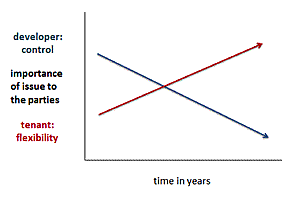
Don’t worry about the substance of this negotiation. Focus on the interaction instead. Here’s all you need to know as background: Nils (the prospective tenant) is in the more powerful position. The developers (Daniel and David) need a commitment from a nationally known retail chain in order to secure project financing and to attract customers to its new mall. The clauses being discussed define how the tenant may use the space it leases. Naturally, Nils wants to have as much flexibility as possible, so his company can adapt its marketing strategy to changing conditions. By contrast, the developers want to maintain as much control as possible. Among other things, they want to be sure that this “anchor store” does not compete with smaller tenants. Tighter control is especially important for the developer in the early years of operation.
Analysis: Setting the Table
Let’s begin with the questions posed before you viewed the clip. First, there are both advantages and drawbacks to having a team negotiate on behalf of one party. Added insight is one potential benefit. Two heads are often better than one, especially if the negotiators have complementary outlooks and expertise. One person may be better at financial analysis, for example, while the other may be more aware of implementation issues.
Moreover, the need for teammates to prepare together may force them to think more deeply about their goals and strategy than if they were simply working alone. And once they’re at the table, each team member will have the benefit of a second pair of eyes and ears to gauge their counterparts’ point of view. In some cases it can make sense for one teammate to do most of the talking while the other listens intently.
But having a teammate can also complicate the negotiation process. It is important that the team speaks with one voice. Any difference its members have about priorities and approach should be resolved beforehand, or at least not revealed in front of its counterpart. Otherwise the team may cause confusion and lose credibility. (Internal dissent may tempt the other side to try a divide-and-conquer approach.) In all but the simplest cases, teammates should plan on caucusing privately throughout the process, so that they can compare their impressions and, if need be, adjust their strategy.
A negotiator operating alone need not worry about coordination. They can proceed at their own preferred pace, and be agreeable or obstinate without fear of contradiction. A solo negotiator may be more agile as a result, able to respond to opportunities and obstacles more quickly without worrying about what their teammate favors. But negotiation is also a physical act; it requires concentration and stamina. Having a teammate can lighten that load.

Negotiators, whether alone or with a teammate, must also consider how they engage the people with whom they will deal. The classic book Getting to Yes by Roger Fisher, Bill Ury, and Bruce Patton counseled “separate the people from the problem.” It’s a fundamental matter of attitude. The tougher the issues, the more important not getting sidetracked in petty squabbles is.
But the authors also recommended that parties be physically aligned, as well. “It helps to sit literally on the same side of a table and to have in front of you the contract, the map, the blank pad of paper, or whatever else depicts the problem.” Where possible, they said, structuring the negotiation as a “side-by-side activity” encourages the parties to “jointly face a common task.”
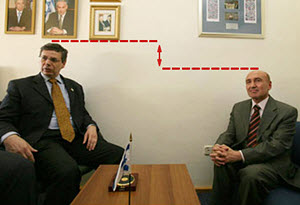
Some hardball negotiators do just the opposite. They try to practice one-upmanship, sometimes quite literally, by manipulating the setup. In 2010 an Israeli Deputy Minister summoned the Turkish ambassador to rebuke him for a television series that had been airing in the latter’s country. The host put himself in a taller chair and his guest in a lower one. He also removed a Turkish flag from the table.
Whatever were the Minister’s intention, the tactic backfired. The photo was published worldwide and the tactic roundly criticized as petty and ultimately self-defeating. The already tense relationship between the two countries worsened.
By contrast, the three negotiators you just saw in the video clip did not use such gambits. Whether by accident or by design, they made the best of the cramped space they were working in. David was at the head of the table. If instead he had chosen to sit next to Daniel and opposite Nils, the setup would have reinforced an us-against-you stance. By being in the middle, David made the table less of a barrier. It gave him a good view of both his counterpart and his teammate. If he chose to, he could follow the Getting to Yes advice by having Nils join him in reviewing particular language in the draft lease.
Sometimes, of course, you may have no choice about where you sit at the bargaining table. Other times the seating arrangement may be a highly contentious issue. In the Paris peace talks that finally brought the Vietnam War to a conclusion, formal talks were delayed for months when the principal parties could not agree on the shape of the table.
Some commentators expressed outrage at the tragedy of having hundreds of soldiers and civilians perish daily while diplomats seemed to be quibbling about furniture, but more was at issue. North Vietnam and its ally, the National Front for the Liberation of South Vietnam (also known as the Viet Cong or NLF), refused to recognize South Vietnamese government. South Vietnam, in turn, would not recognize the NLF. The issue of legitimacy was central to the conflict.
North Vietnam insisted on a circular table where all four parties would have equal status. In contrast, the South Vietnamese government insisted upon a rectangular table where it would sit next to the US representatives. Opposite them would be North Vietnam and the NLF.
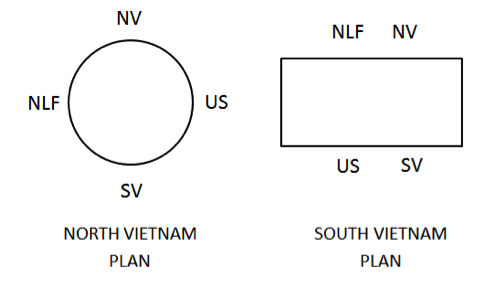
After months of stalemate, chief American negotiator Averill Harriman proposed an arrangement that would allow NLF representatives to be seated near the North Vietnamese team without being acknowledged by the South Vietnamese. And the South Vietnamese could be seated near the American delegates without being formally recognized by the North Vietnamese. What setup would you propose? Think about that for a moment, then click here to see what the four parties agreed to.
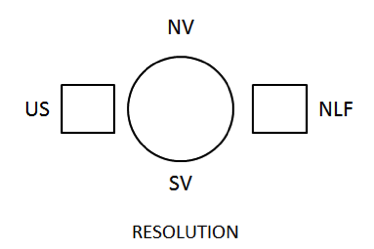
It’s impossible to know whether the deadlock would have been broken earlier if someone had made this proposal at the outset. Other factors may explain the stalemate. But once the parties had locked themselves into a particular design (the circle or the rectangle), it’s unlikely that either side would have accepted the other’s idea. At the very least, Harriman’s solution was a successful face-saving device.
Starting the Negotiation
You likely noted that Daniel (the developer seated in the middle) did most of the talking in the first minutes of the video clip. It’s not clear if this was intentional on his part. Some research studies suggest that negotiators in a weaker position tend to talk more than stronger ones do. They may feel the need to justify their claim to a fair deal. By contrast, those who are more secure expect to get a good outcome, so are under less pressure.
Some previous viewers credit David for setting a positive tone and emphasizing that both parties share an interest in ensuring the success of the new shopping center. Nils (the prospective tenant on the right) is positive, as well.
Did you note, for example, how he affirmed David’s early comment that they already “have had a couple of go’s back and forth” to finalize the lease? Even before David finishes that sentence, Nils jumps in with a positive comment: “We’ve come a long way.” At other points Nils nods his head in affirmation. A bit later, though, he reminds the developers of the greater size (and power) of his own company by saying that this project would be store number 201 for them. Then noting his experience, he adds, “I’ve been here before.”
You can see David’s attempts to set a cooperative tone and the way in which Nils echoes that sentiment while also establishing his power by reviewing the video. At the end of this exchange, David shifts gears by asking, “What is the most important thing to you?”
Throughout all of this Daniel has been quiet (though he gets more involved later). With a team, having one member open up the conversation may be wise, rather than have two attempt to perform a duet. But Daniel’s eyes are down. He seems absorbed in his notes. Perhaps he is checking some important information. (Or he also may be aware of the camera.) Yet even if one teammate chooses to be silent, they can engage other parties at the table by paying attention to what they do and say.
It is easy to observe these patterns—who’s doing the talking and how others are responding—when viewing a video of strangers. But monitoring interpersonal dynamics is more challenging when you are an active participant with a personal interest in the outcome.

In his book Getting Past No, Bill Ury emphasizes the importance of “going to the balcony.” To be effective, a negotiator must be mentally in two places at the same time. They must be center stage, of course, deeply engaged with other parties. But simultaneously a negotiator must maintain the detached perspective of someone in the audience, perched way up in the last row of the balcony. Only then is it possible to have a wide angle view of all the actors and how they relate.
The higher the stakes in a negotiation, the easier it is to turn attention inward and focus on private feelings and what to do next. Yet it is precisely at such moments where the view of the unfolding process from the balcony is most important.
The Dance of Negotiation
After the three students completed the negotiation exercise, they were asked to review the video and select several critical segments that they wanted to analyze with the instructor. One of these moments was the opening clip that you just saw.
In the debriefing, the instructor stopped it exactly where the clip ends here. “Did you see that?” he asked. He wasn’t noting the seating arrangement. Nor was he commenting on how David did most of the talking. In fact, what he observed could have been seen with the audio turned off.
Did anything about their physical behavior catch your eye? If not, go back and rerun the clip, this time without the sound. Sit back as if you were in the balcony. Rather than concentrate on any one individual, try to see them as one entity, an evolving organization taking shape.
Perhaps you caught it this time. Perhaps not. In any event, here’s what the instructor showed the students when he replayed the tape. These are freeze frame images of four moments, several seconds apart. Click here to view them.
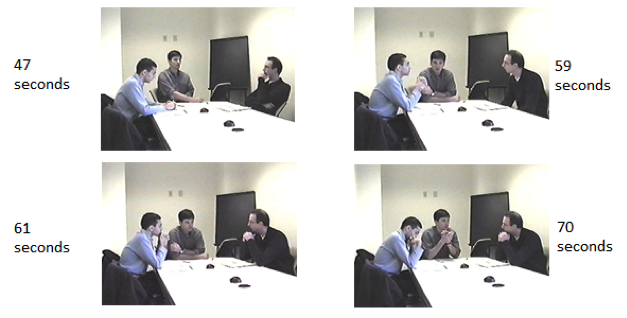
Now it should be clear. Within a matter of seconds, Nils’s behavior—having a hand on his chin—had migrated to Daniel, back to Nils, and then over to David. At the end, in little more than 20 seconds, they are now leaning into the conversation.
It’s instructive that these three people weren’t aware of this mirroring when it happened. Nor did they see it when they first reviewed the video—or even the third time around with the instructor. They were amazed. And naturally they wondered what it meant.
The question, however, is not whether putting your hand to your chin is a sign of ease or discomfort. Individual gestures like that are usually ambiguous. What’s significant is that the three people were doing the same thing at the same time. It’s called mirroring, and it’s closely related to a phenomenon called emotional contagion.
Our facial expressions and body posture reflect our mood. Other people pick up on that, often unconsciously. Studies show that when subjects sit in a room with someone else who is relaxed and serene, they calm down, too. By contrast, if the person is anxious and fidgety, whoever joins them is likely to become more tense, at least to a degree. Put two people with different heart rates together and the pulse of the higher one will slow down somewhat and the other’s will go up. These physiological signals can foster connection between people, whether they are engaged in negotiation or speed dating, or they can inhibit successful relationships. For more on this topic, visit the Getting in Sync module.
Summary
The broader lesson here is about observation, the ability, even in stressful situations, to attend to interpersonal dynamics—what people say, do, and feel in relation to one another. It is both a skill and more fundamentally an attitude of openness and curiosity.
Perhaps you saw the mirroring the first time you saw the clip. Or maybe it required a second look. Whichever it was, it is far easier to see patterns in other people’s behavior if you don’t have a stake in what they are doing and saying. Were you in this video yourself, it would be hard to resist the impulse to focus on yourself (whether with an approving or critical eye). The challenge—and the reward—lies in being able to step back and see the interaction as a whole.
You can develop this ability through practice. Your professional and personal life will give you plenty of opportunities to learn. Stay awake in a tedious business meeting by watching how people’s posture reflects their weariness. Can you spot moments when they could be re-energized? In the movies, note how much is expressed when one great performer reacts to another with a tilt of the head or a raised eye, all without saying a word. And, of course, when you are in a negotiation yourself, either as the lead actor or someone with a small part, remember to be both center stage and also up in the balcony.
Additional Resources
- Jeanne M. Brett, Ray Friedman and Kristin Behfar, How to Manage Your Negotiating Team, Harvard Business Review, 2009.
- Michael A. Wheeler, Dana Nelson, Non-Verbal Communication in Negotiation, Harvard Business Review, February 11, 2003.
- Elizabeth Long Lingo, Colin Fisher, and Kathleen L. McGinn, Negotiation Processes As Sources of (And Solutions To) Interorganizational Conflict, HBS Working Knowledge, July 12, 2002.
- Benedict Carey, You Remind Me of Me, New York Times, February 12, 2008.
